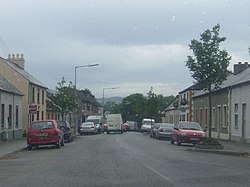Carrigans, County Donegal
| Carrigans Irish: An Carraigín | |
| County Donegal | |
|---|---|

| |
| Location | |
| Grid reference: | C367117 |
| Location: | 54°57’6"N, 7°25’43"W |
| Data | |
| Population: | 331 (2016) |
| Local Government | |
| Council: | Inishowen |
| Dáil constituency: |
Donegal |
| Website: | stjohnstonandcarrigans.com |
Carrigans is a village in The Laggan, a district in the east of County Donegal. The village is located on the R236 regional road only a short distance from the River Foyle.
The village's parish church is Killea Church or St Fiach's, in the Church of Ireland.
History
Carrigans was at one time the centre of a major flax and linen producing area, possessing one of the largest flax mills in County Donegal, before the demise of the flax industry in the 1950s. Commercial salmon fishing was also a major employer in the past.
Carrigans once had a railway station, on the Great Northern Railway. It closed in 1965.
The Bangalore torpedo, an explosive device used in many conflicts, was invented by Captain (later Colonel) McClintock, of Dunmore, Carrigans.
Carrigans was one of several Protestant villages in eastern Donegal that would have been transferred to Northern Ireland, had the recommendations of the Irish Boundary Commission been enacted in 1925.[1]
Dunmore House, on the edge of the village, was formerly the home of the McClintock dynasty, an Ulster-Scots family. It is now owned by Sir John McFarland, 3rd Baronet. The writer Agatha Christie visited Carrigans on a few occasions, as a guest of the McClintocks of Dunmore, to whom she was related through marriage.
Outside links
References
- ↑ "Irish Boundary Commission Report". National Archives. 1925. p. 140-43. http://discovery.nationalarchives.gov.uk/details/r/C386829.
- An Carraigín / Carrigans: Placenames Database of Ireland